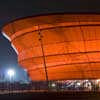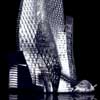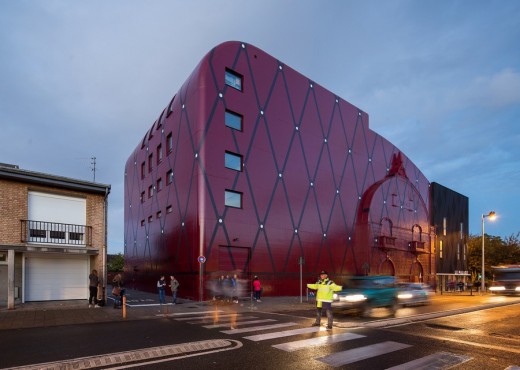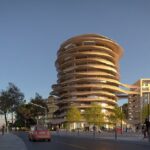National Drama Theater Bethune Building, Nord-Pas-de-Calais, France, Architect, Images
National Drama Theater
Performance Facility Building Béthune, France – design by Manuelle Gautrand Architecture
18 Mar 2015
National Drama Theater in Bethune
Architects: Manuelle Gautrand Architecture
Location: Béthune, Nord-Pas-de-Calais, north France – located near Calais
Firstly named “National Drama Center of the Nord Pas de Calais” then “Theater of the Northern Countries” and finally renamed “La Comédie De Bethune” by Agathe Alexis and Alain Barsacq who managed it from 1992, this theater distinguishes itself by its location in the heart of a territory marked by the crisis.
Since the 1980s, culture has become a priority in the development of the Nord-Pas-de-Calais area; “La Comédie De Bethune” reflected the will of the elected representatives of the department to be equipped with a National Drama center.
Place of reference and artistic excellence where the theater can express itself in all its forms and reach all audiences, the building contributes strongly to the attractiveness of the area and represents the most emblematic cultural equipment of the city.
Installed in a marquee with three hundred seats in 1992, the theater moved in 1993 in an old powder magazine, built by Vauban and refurbished into a «Studio Theater» which is still used nowadays.
There was initially a movie theater called «The Palace» built in the 1930s on the present site of “La Comédie De Bethune”. The facade of the building maintained by girders, was all that was left when it was demolished in the 1990s.
In 1994, the agency MANUELLE GAUTRAND ARCHITECTURE won the competition for the construction of the theater. From the beginning, the project anticipated what has now become an extension: it already was in the form of two functional sections, the first one containing most of the program, which was then carried out, the second one immediately unrealizable because it was positioned on the corner of the plot, involving the demolition of a house.
From 2009, the corner house having been demolished, the extension of “La Comédie De Bethune” was able to be realized at the same time as the renovation of the existing theater. The agency MANUELLE GAUTRAND ARCHITECTURE, laureate of a new architectural competition for this extension, took advantage of this unique opportunity to improve and complete the global functioning of the theater and endow it with a rehearsal room allowing the presence of the artists on the site.
The building delivered by the agency in 1999 included most of the features, but compared to a conventional theater, there was still missing a rehearsal room for the artists (provided by the current extension).
This fi rst piece has been installed «around» the conserved house on what was available on the plot, adopting a “S” form complicated by this context. A big part of the plot was naturally dedicated to the room and its direct additional premises (dressing rooms, backstage, state control) while the narrowest part of the north was for the rest of the functions, with the lobby, the administration, and the accompanying facilities (toilets, technical rooms. …).
The implementation of a slightly sloping ground at the ground floor has permitted to add at the very last moment a coffee bar under the slope of the flowerbed of the room, so as to create a friendly place, both to the artists and the public.
In order to capture the best of this complex and narrow site, the architectural concept had been to create a very compact project with spaces close to each other, and facilitating the displacements from one space to another. The program was divided into two parts sharply juxtaposed: one intended for the artists, opening on the boulevard Victor Hugo, and the other one intended for the public facing the November 11th street.
This second part was the smallest, its more complex volume was inserted in the artists’ building: the fl at and regular floor of the ground floor, came down from the November 11th street where is located the lobby, up to sunken the boulevard Victor Hugo where was the bar. The bar was under the slope of the bleachers of the room, the whole arrangement created a very fluid and unitary space, sliding from one end to the other of the plot.
Inside the section intended for the artists, the functions are linked and follow each other with rigor: on one side the back-stage, on which all the cabins of the artists and their accompaniment premises are superimposed, then the scene, the proscenium, and finally the room on which comes to settle in height the state control, above the back seats. The scene is constituted by a tray of 240 m ² with a stage bellow on the same surface, and above the grid and the false grid. The proscenium also has a grid that can be equipped. The distance between the lowest point of the bottom of the scene and the highest point of the grid is 21 meters.
The building represents a very large volume entirely in concrete varnish in dark purple. The shape of this volume is slightly curved and rounded, giving it an almost precious appearance and certain softness.
Manuelle Gautrand did not attempt to hide the important volume of the building, but to assert this shape, and improve it by rounding it and dressing it entirely in purple varnish. This warm color used several references: the theater, often red through the ages, a timeless and strong color. It is also a reference to the Northern bricks, to the colored facades that goes from red to brown through purple. When the color of the bricks is not bright enough to contradict the gray sky, they are often painted, reinforced with large fl at glowing which is brightening up the city. The facades thus present a monumental aspect and distinguished themselves by their purple satin color. The surface of the varnish is covered with a pattern from stencil, drawing very graphically a frieze of black glazed bricks, from the fl oor to the top. This stylized frieze has allowed giving a certain scale to the facades of this part of the project.
Furthermore, the other element coming to recall the scale of the environment is the facade of the former movie theater identically reproduced since it’s a part of the historical heritage of the residents of Bethune.
Today, the street corner house having been demolished, the extension was able to be realized after 16 months of work, partially in occupied site. The agency Manuelle Gautrand Architecture took this opportunity to put in the current building safety regulations (which have changed since 15 years).
The project reached two main goals:
•Realize the extension, planned since 1994, including the rehearsal room
•Put in the new safety regulations and renovate the theater (the administration, the hall…).
The Extension:
The extension is located on the corner of the plot, on three levels: a volume of high-rise located on the same level as the natural ground, and dedicated to the rehearsal room; then a level of offices, which links with the existing office floor to the second fl oor of the building.
The size of the rehearsal room allows relocating the hall on the corner of the November 11th street and the Avenue Victor Hugo, a provision that already existed during the competition in 1994. This position has several advantages: it allows to give a better visibility to the theater and to make the coffee bar more accessible. The coffee bar formerly located under the volume of the room’s floor, could not benefit neither of a direct entrance from the Avenue Victor Hugo, nor a natural lighting.
Now, the construction of the hall corner connects directly to the coffee, bringing a natural lighting and making it an animated and welcoming passageway.
Above, the administration has a larger and more functional space thanks to the extending from the second floor of the existing theater.
Restructuring of the Existing:
Many spaces have also been changed within the existing building. Indeed, since the delivery of the original
building fifteen years ago, the safety regulations have evolved considerably. This project therefore involved the upgrading of the entire building. Several safety regulations were concerned, including the fi re safety regulations and the accessibility to all spaces of the theater for disabled people.
The extension also required the construction of a staircase located on the right of the future hall and serving on the first floor the upper level of the rehearsal room of the CNAD (National Academy of the Dramatic Arts) and its additional premises, and the offi ces on the second floor. Finally, the building reached the most ambitious thermal and energy regulations.
The Room Above the Pit:
The agency used all these work to complete this room, which had been left «raw» during the construction of the original building, into a second rehearsal room without grid, and smaller than the main rehearsal room, with an access facilitated by the raising of the staircase of the offices.
Architectural Guidelines for the Extension:
As mentioned previously, this extension was wished for a long time by the City and by “La Comédie De Bethune”, because only this extension could complete this ambitious program. Therefore, the extension has been the missing piece for more than ten years, and the possibility of acquiring the corner plot by the City in 2009 had fi nally permitted to achieve this main goal.
Today, the theater fi nally fi nished is a magnifi cent tool for the comedy: it’s a brand new «tool» ready for a new generation of actors and stage directors…
This project was important for the agency because it’s rare to be able to intervene again on a building fifteen years after its delivery. It’s the timeliness to see how the work of the agency lived, how the users have suited it, and in reality, this is a wonderful opportunity that create a real attachment: an attachment to the building that the agency has conceived, then built, then extended… but it’s also an attachment to the users, to the City of Bethune who have accompanied these two architectural adventures.
However, it was not that easy to extend the huge round and purple volume of the theater, especially after 20 years … The agency didn’t wanted to extend the existing architecture with the exact same style, but preferred to exploit two different periods.
Finally, the building had an even longer history, linking three periods: Before the theater in 1999, there was the movie theater of the 1930s, for which the agency had kept the facade. Therefore, it’s not two architectural periods, but three …
For the extension, Manuelle Gautrand took the architectural concept of a simple volume, almost rectangular, which comes to close the angle between the Boulevard Victor Hugo and the 11th November street.
Symbolically this extension seems to connect all the functions, to facilitate the displacements of the users:
the lobby envelops the new rehearsal room to open itself on both streets. The lobby connects successively the historic hall, the new rehearsal room and the room on top of the fl ower-bed. Its length allows installing several bars that create more places of breaks dedicated to the artists or the audiences.
The Facades: A Subtle Staging Around the Black
The conception of the facades had to integrate the highly visible part of the initial project, this large rounded volume with the smooth corners, fully lacquered in purple. And it was not so easy to juxtapose a renewed style…
Finally, it’s in black that the agency coated this extension: a deep and powerful color. To create a soft link with the initial volume, this black is implemented in the form of a kind of weaving metal panels, which are drawing large rhombuses, to remind the ones of the purple rounded shape.
The rhombuses thus seem to go from one volume to another; they are declined in two different forms. Indeed, on the existing building the rhombuses are drawn using stencils on the concrete, and on the extension, the rhombuses are drawn in crossed metal cladding, mixing successively “black mat” and “glossy black” panels.
The existing building is assembled on a diagonal frame which allows attaching those shaped panels. The waves of these panels, mat and glossy, take the light differently, depending on their degree of shine and their orientation to the light. Besides this extension of the huge rhombuses drawn on the existing purple facade, there is a delicate inspiration taken from the artist Pierre Soulages’ work.
Finally this beautiful corner piece completes the project with a deep black and powerful volume: a way of asserting the theater’s anchor in the city of Bethune.
And at the same time, this “dark” black is sometimes extremely light when the daylight faces the façade of the building, as it does in the paintings of Soulages … The black becomes shiny, bright, and almost white. The building is refi ned and alleviated; it becomes almost crystalline, thus completing the round existing volume with a stricter and more geometric shape.
The challenge of the project was also to improve the thermal and environmental performances of the restructuring and the extension. The existing building already had very good thermal performances, thanks to an effective insulation. For the extension these qualities are improved with a very thick outer insulation coated with the metal cladding. The heart of the project remains in the coherence of the initial tints: A mixture of dark shades, going from black to purple.
Only the furniture of bars and desks, which meshes along the path, is coated with a very brilliant white, which illuminates these friendly places. The white of the furniture is also on the walls, creating bright and almost fl uorescent inserts in the black walls. The light of the ceiling is constituted with long fl uorescent tubes that remind the folds of the black cladding bleached by the daylight.
One of the last choices in the draft was to think about progressively erasing the presence of the former facade of the movie theater. As if a generation was chasing away the previousone, the facade preserved and restored in the previous project, with its fi llers pastels and a little outdated, has been completely covered with the purple lacquer, as if the rounded hull had swallowed it.
And here is this theater, to which the agency became so much attached, ready for a new life!
National Drama Theater – Building Information
Project: Extension – restructuring of the National Drama Theater « Comédie de Béthune »
Contracting Authority: Communaute D’agglomeration De Bethune (Artois Comm)
User: La Comedie De Bethune
Architect: Manuelle Gautrand Architecture
Engineers & Consultants
Stage design: Bati-Scene
Structural engineering: Khepgren
Acoustics: Jean-Paul Lamoureux
Fluids engineering & economy: HEXA INGENIERIE
Scheduling and coordination: HD Project
Main Firms
Shell : Ramery
Façades : Diter
Partitions – ceilings : C4M
Woodwork : Bara Menuiserie
Painting-wall coatings : Vandendriessche
HVAC and plumbing : Bonnel
Electricity – Networks : Eiffage Energie
Stage equipment: Caire-Manganelli
Figures
Surface : 2.0820 sqm in total, including extension of 720 sqm
Extension & restructuring cost: about 3,6 million Euros including all taxes
Theater of 350 places, with grid, 15-meter high and 14-meter large scene frame, 15,50-meter large and
13,50-meter deep theater fl oor with trap room, grid and fake grid. Rehearsal space with grid.
Dates
– Initial building : competition: 1994, delivered in 1999.
– Extension-restructuring: competition : 2009, Studies:
2010-2013, Construction: 2013-2014, Opening of the new theater with its rehearsal space : september 2014.
Control Office: Preventec
Photographs © Luc Boegly
National Drama Theater in Béthune images / information from Manuelle Gautrand Architecture
Location:a Comédie De Bethune, Béthune, Nord-Pas-de-Calais, France ‘
New Buildings in France
French Architectural Projects
French Architect Offices – design firm listings
Paris Architecture Tours by e-architect
French Architecture – Selection
Zenith Saint-Etienne Building
Design: Foster + Partners, architects

photo : Nigel Young
Zenith Music Hall Strasbourg
Design: Massimiliano Fuksas Architecture

photo : Moreno Maggi
The Phare
Design: Morphosis, architects

picture from architects
Website : Béthune France
Comments / photos for the National Drama Theater in Bethune page welcome
National Drama Theater in Bethune
Website : France
Website : Manuelle Gautrand Architecture



















